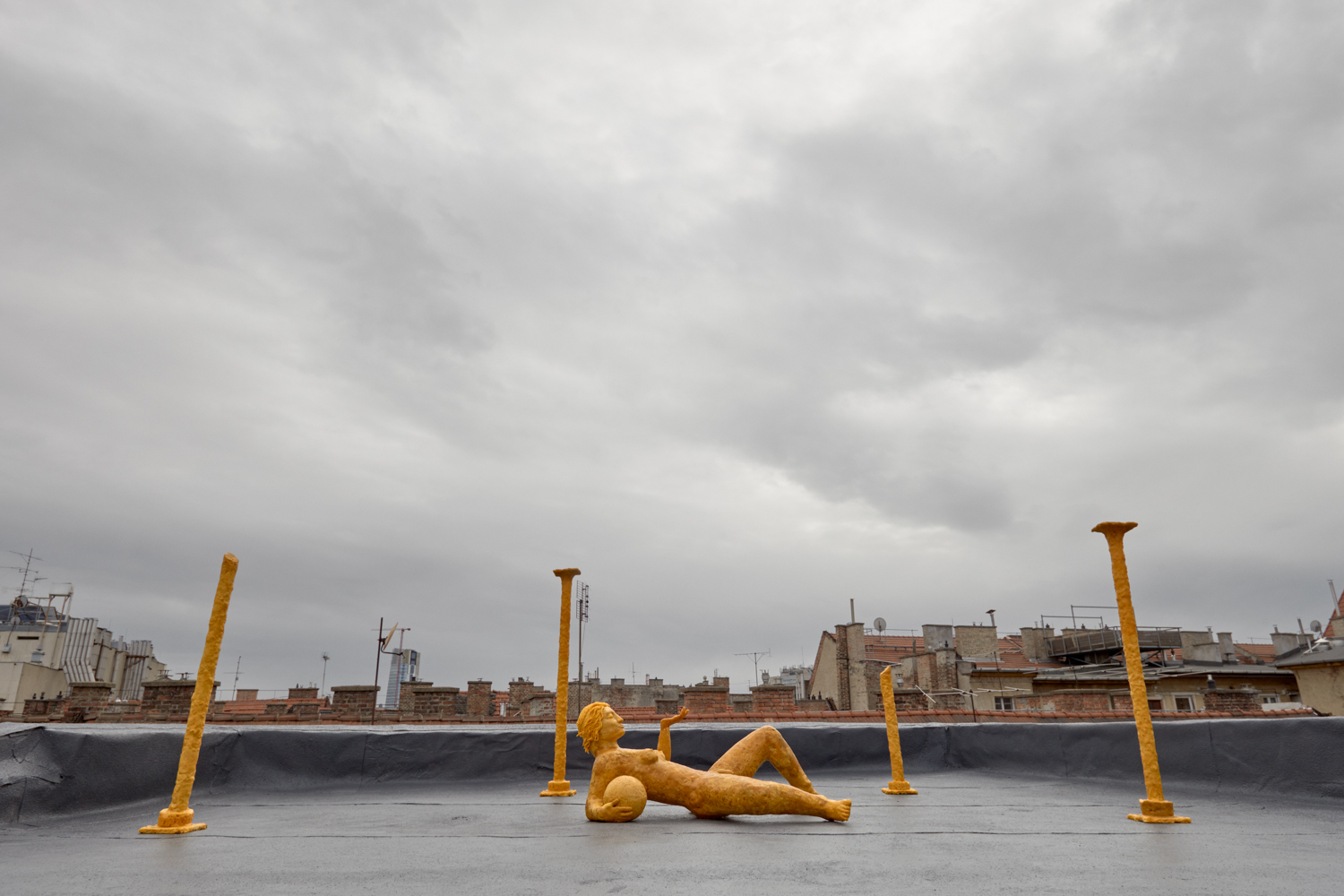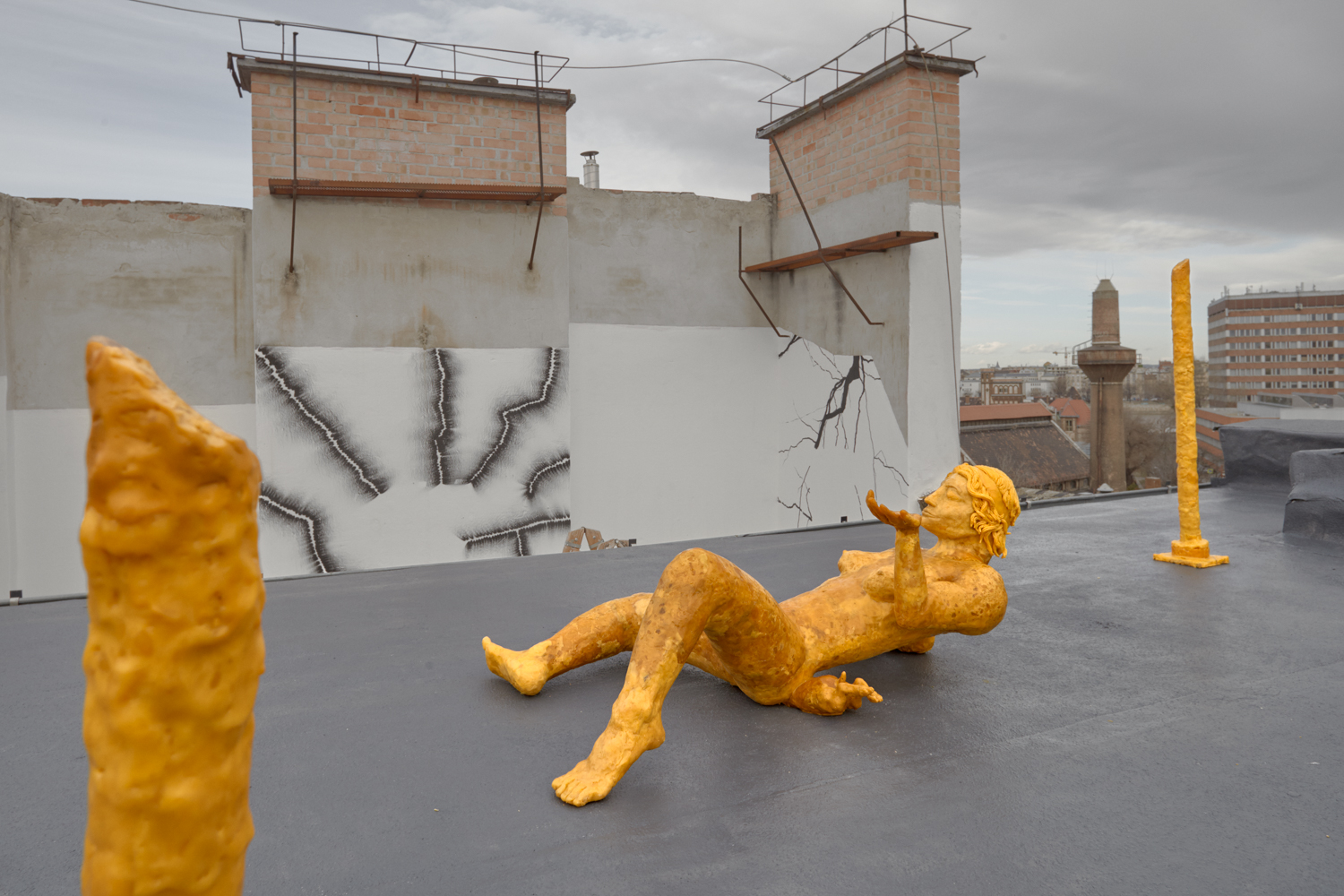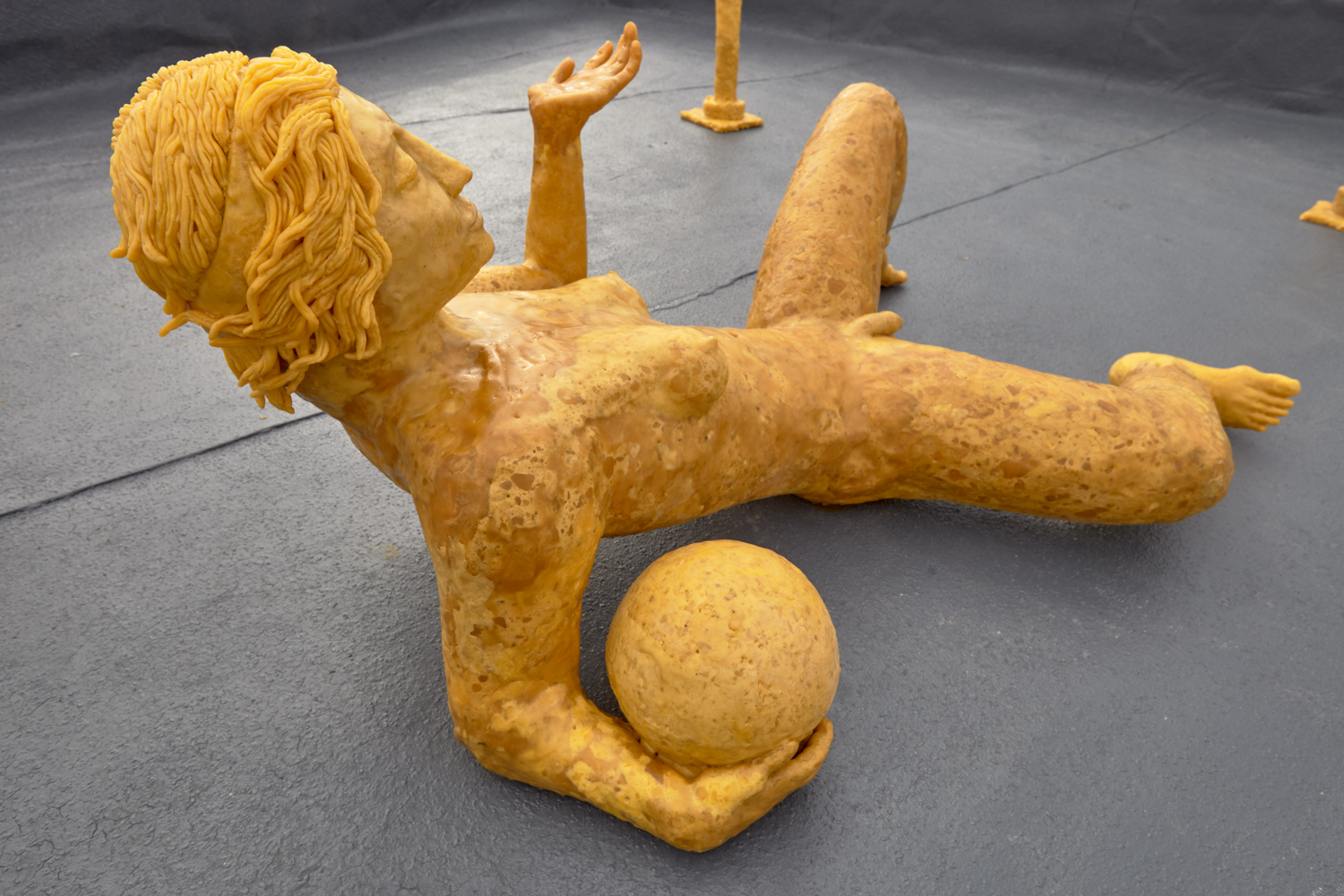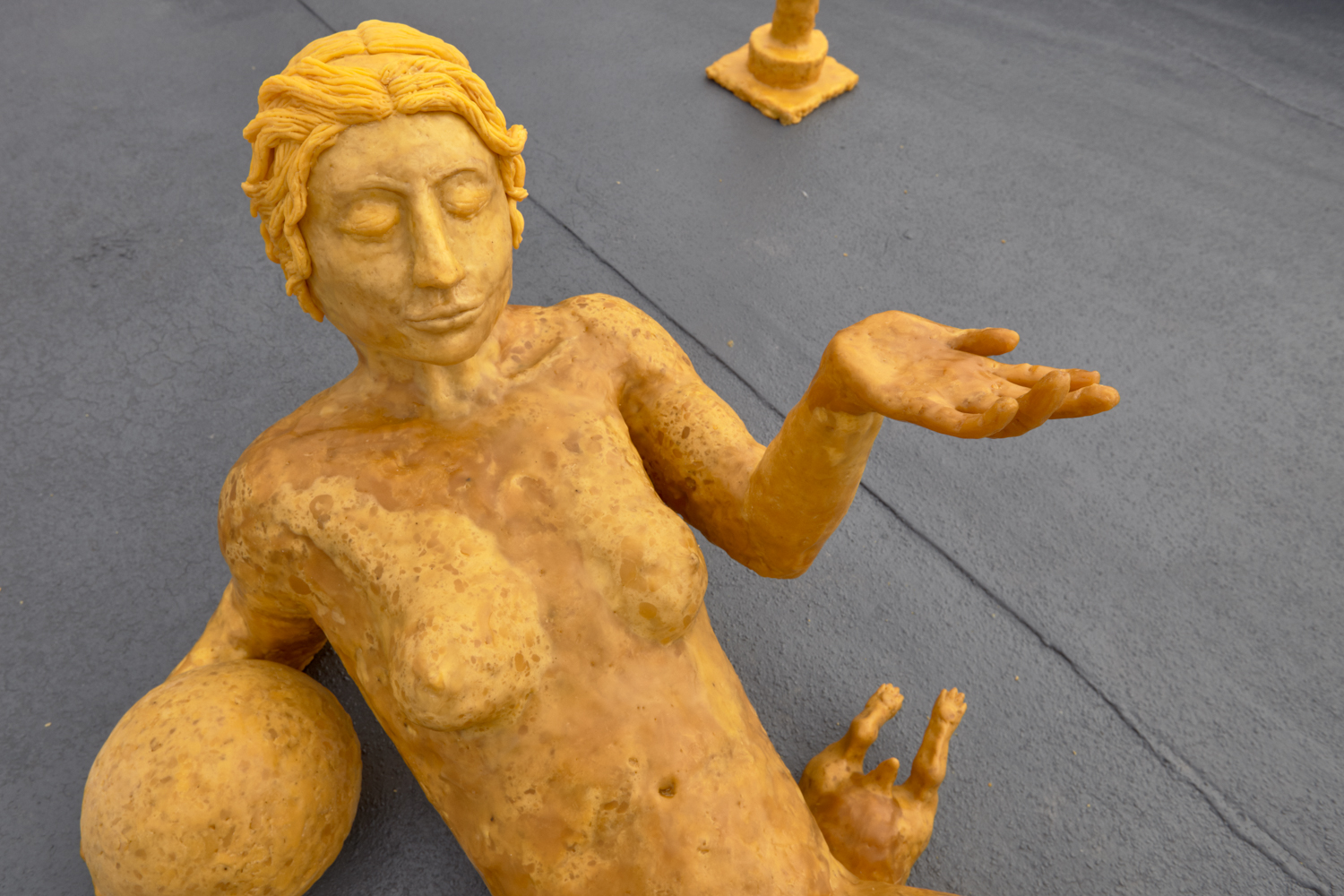gideonhorvath.com
Kiss of the Sun (2022)
Exhibited at ENA viewing space
Curator: Péter Bencze
![]()
The antique statue of the Sleeping Hermaphroditus was unearthed in Rome in the 17th century, but several copies of it exist. The original statue was complemented by a marble bed by Gian Lorenzo Bernini, and the work can be seen in this form in the Louvre. At first glance, the back of a beautiful female body unfolds in front of the viewers, lying on the padded bed radiating sincere serenity. However, the sleeping hermaphrodite keeps a secret. It is only by going around the statue and looking at the other side that they realize that the feminine figure also has male genitalia. A recurring element of cultural topos related to hermaphrodism, intersexuality, and transgenderism is this surprise factor: “She’s a very beautiful woman, only if you know what’s under her skirt!”. These oppressed members of our society often play the role of mentally impaired criminals in books and films. However, the original antique sculpture cannot be interpreted solely in terms of binary gender roles or the abnormality that differs from them. The reclining figure radiates serenity, the pose seems self-evident. He/she is not disturbed by the searching gaze, as he/she apparently lies naked on the bed voluntarily, in fact, hermaphroditus almost empowers the viewer to thoroughly examine and study the seemingly ambivalent details of his/hers figure with his gaze.
In ancient Greece and Rome, to the best of our knowledge, hermaphrodite children were a distinctly bad omen. The sculptures made of them were intended exclusively for the male gaze. Ovid in Metamorphoses wrote about the history of the origin of the Hermafordite. According to the story, the incomparably beautiful Hermaphroditus was the son of Aphrodite and Hermes. At the age of fifteen, during his travels, he found the small lake of the nymph Salmacis, where the nymph, not caring about the boy's rejection, threw himself at Hermaphroditus. Salmacis was so flooded with desire to have sex with the boy that she asked the heavens to make them one. The gods listened to her request and granted it. As a desperate revenge, Hermaphroditus asked them to curse the waters of the lake, whoever would enter, became impotent.
The Ovidius narrative — which is, of course, just one of many stories of origin — illustrates that our relationship to sexuality and gender identities has always caused many internal and external conflicts. Thus, the current discourse on the social integration of transgender people is not new. While these discourses are indispensable and hopefully constructive, we often run into the mistake that because the issue is discomforting to us, we want to take a stand immediately. We have a hard time recognizing ambivalence and accepting its inevitability. Furthermore, in the theories, conversations, and debates that move on an abstract level, we often forget the specific, tangible human stories that still weigh heavily on individuals who are unable to face them alone.
Ambivalence and isolation are also central to the installation seen in the ENA Viewing Space. The kiss of the Sun captures the moment of grace that we can all experience when, in situations full of ordeal, as a kind of instinctive escapist gesture, we turn to the Sun with our eyes closed to leave the difficulties that accompany us for a few seconds. We can escape the problems of the Earth in this independent, warm space all while experiencing an undeniably universal human experience.
Gideon Horváth
![]()
![]()
![]()
![]()
Az alvó hermafrodita antik szobrát a 17. században, Rómában tárták fel, de több másolata is létezik. Az eredeti szobrot Gian Lorenzo Bernini egészítette ki egy márvány ággyal, a mű ilyen formájában a Louvre-ban látható. Első ránézésre egy gyönyörű női test háta tárul a nézők elé, aki a párnázott ágyon elterülve őszinte nyugalmat áraszt magából. Az alvó hermafrodita azonban egy titkot őriz. Csak a szobrot megkerülve döbbenek rá, hogy a feminin alaknak férfi nemi szerve is van. A hermafrodizmushoz, interszexualitáshoz és transzneműséghez kapcsolódó kulturális toposzok visszatérő eleme ez a meglepetés-faktor: „Nagyon szép nő, de tudnád, mi van a szoknyája alatt!”. Manapság ezek az elnyomott társadalmi szereplők könyvekben és filmekben túlnyomó részben a mentálisan sérült bűnözők szerepét töltik be. Ugyanakkor az eredeti antik szobor nem kizárólag a bináris nemi szerepek, illetve az azoktól eltérő abnormalitás felől értelmezhető. A fekvő alak nyugalmat sugároz, póza magától értetődőnek tűnik. Nem zavarják a fürkésző tekintetek, hiszen láthatóan önszántából fekszik meztelenül az ágyán, sőt, mintegy felhatalmazza a nézőt, hogy tekintetével alaposan megvizsgálja és tanulmányozza alakjának ambivalensnek tűnő részleteit.
Az ókori Görögországban és Rómában legjobb tudomásunk szerint a hermafrodita gyermekek kifejezetten rossz ómennek számítottak. A róluk készült szobrokat kizárólag a férfi tekintetnek szánták. Ovidius az Átváltozásokban írta meg a Hermafordita eredettörténetét. A történet szerint a páratlanul szép Hermafroditosz Aphrodité és Hermész fia volt. Tizenöt éves korában, utazásai során talált rá Szalmakisz nimfa kis tavára, ahol a nimfa mit sem törődve a fiú elutasításával, rávetette magát Hermafroditoszra. Szalmakiszt annyira elöntötte a vágy, hogy közösülhessen a fiúval, hogy az égiektől azt kérte, tegyék őket eggyé. Az istenek meghallgatták a kérését és teljesítették azt. Hermafroditosz kétségbeesett bosszúként azt kérte tőlük, hogy a tó vize legyen átkozott, aki belelép, váljon impotenssé.
Az ovidiusi elbeszélés – amely természetesen csak egy a számos eredettörténetből – szemlélteti, hogy a szexualitáshoz és nemi identitásokhoz fűződő viszonyunk mindig is sok belső és külső konfliktust okozott. Nem újkeletű tehát a Magyarországon és globálisan is aktuális diskurzus a transzneműek társadalmi integrációja körül sem. Míg ezek a diskurzusok nélkülözhetetlenek és remélhetőleg konstruktívak is, sokszor futunk bele abba a hibába, hogy mivel a kérdéskör zavarba ejt bennünket, azonnal szeretnénk állást foglalni. Nehezen küzdünk meg az ambivalenciával és fogadjuk el annak megkerülhetetlenségét. Továbbá az absztrakt szinten mozgó elméletek, beszélgetések és viták közben sokszor felejtjük el azokat a konkrét, kézzelfogható emberi történeteket, amelyek ma is olyan súllyal nehezednek egy-egy egyénre, amivel képtelenség egyedül szembenézni.
Az ENA Viewing Space-ben látható installációban is központi az ambivalencia és az elszigeteltség. A Nap csókja azt a mindannyiunk számára átélhető kegyelmi pillanatot örökíti meg, amikor megpróbáltatásokkal teli helyzetekben, egyfajta ösztönös eszképista gesztusként, csukott szemmel a Nap felé fordulunk, hogy pár másodpercig magunk mögött hagyjuk a minket kísérő nehézségeket. Ebbe a független, meleg térbe menekülhetünk a földi problémáktól, miközben egy tagadhatatlanul univerzális emberi élményt élünk át.
Horváth Gideon




